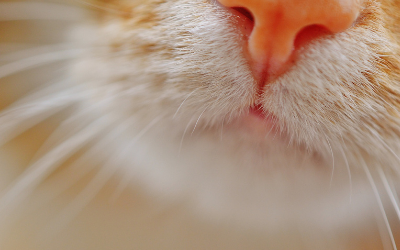There is no delicate way to ask. This particular issue is as sensitive as a cat’s sense of smell. To address why cats sniff rear ends, it 
Do cats really have a good sense of smell?
Like humans, cats have five basic neurological senses: taste, touch, hearing, sight, and smell. Of these senses, smell takes the lead in the feline world. A cat's sense of smell is far more advanced than ours. When compared to humans, cats have a smelling ability that is 14 times more sensitive. The human nose contains about 5 million olfactory receptors that detect aromas, while a cat's nose has 45 to 80 (possibly up to 200) million scent receptors.
"Cats also have an additional tool
to enhance their sense of smell."
Cats also have an additional tool to enhance their sense of smell. Cats have a special organ called Jacobson’s organ (or the vomeronasal organ) that is located inside the nasal cavity and opens into the roof of the mouth, right behind the upper incisors. This amazing organ serves as a secondary olfactory system and detects specific chemicals by using nerves that lead directly to the brain. Unlike olfactory cells in the nose, the odor receptors of Jacobson’s organ do not respond to just ordinary smells. Jacobson’s receptors pick up chemical substances that have no odor at all. In other words, they work to detect “undetectable” odors.
Jacobson’s organ communicates with the part of the brain that deals with mating, and its primary function relates to breeding. By identifying pheromones, Jacobson’s organ provides male and female cats with the information they need to determine if a member of the opposite sex is available. In addition, this organ enhances the sense of smell that newborn kittens need to find their mother’s milk source. Kittens can identify their mother from other nursing dams via their sense of smell. If a kitten is placed between two nursing mothers, she will move to the one that gave birth to her.
The two separate parts of the cat’s odor detection system, the nose and Jacobson’s organ, work together to provide delicate sensibilities that neither system could achieve alone. When a cat curls her lips and appears to smile, she opens up Jacobsen’s organ, and air pushes smells into it.
Do cats use smell to communicate?
When two people meet, they evaluate each other’s body language, facial expressions, and tone of speech to quickly assess their relationship. They may shake hands or hug each other, share a casual verbal greeting, overflow with tears of joy, or they may totally ignore each other.
Cats may not verbalize, shake hands, or hug like humans, but they do assess each other. When two cats meet, they usually sniff the head area first or may even share a gentle head bump. This physical greeting releases pheromones from glands in the face. These pheromones tell a lot about a cat, so a cat's sense of smell serves as a form of chemical communication tool.
Biochemical compounds emitted by cats provide the dialogue for chemical communication. The aromas produced provide information to one cat what her new-found friend likes to eat and what sort of mood she is in. By simply smelling a companion, a cat can determine whether they are male or female, happy or aggressive, or healthy or ill. Cats can get a general idea about each other with a quick sniff of the head, but more detailed information can be determined by getting up close and personal.
So how is smelling each other's rear ends part of their communication?
What perplexes many pet owners is why cats would sniff this particular part of the anatomy. Why rear ends? The answer is anatomical. Inside the rectum are two small sacs called anal glands, which secrete a noxious smelling substance into the rectum through a pair of tiny openings. The glands are emptied naturally when the rectal sphincter muscles contract during a bowel movement. Pet owners are usually unaware of this occurrence, since the odor of the anal glands is masked by the odor of the cat’s stool; however, cats can definitely tell the difference.
"When cats sniff rear ends as a greeting,
they can determine a great deal of
information about each other."
When cats sniff rear ends as a greeting, they can determine a great deal of information about each other. Is this cat a friend or foe? Is she going to be a good “date”? Is he aggressive? Is she feeling ill? And because the odor is unique to every cat and serves as a form of identification, two cats can quickly determine if they have met before.
The very act of sniffing rear ends can establish dominance and set the tone of the relationship. The dominant cat will usually initiate the sniffing, while the more submissive cat waits her turn. A submissive cat may end the sniffing and retreat. A dominant cat may stop sniffing and hiss to end the introduction. Some cats are shy and like to limit the information they give out, so they will simply sit down and clamp their tails over their rectums, reducing the odor they emit.

